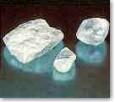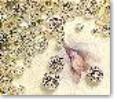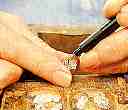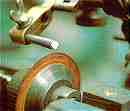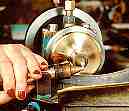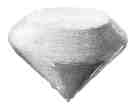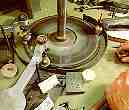 |
Where
quality matters............ |
Diamond
Fashioning
| Infos Historic
Diamonds Copyright
by | Why
are rough diamonds fashioned in the first place? This question is easily answered: because a rough diamond does not exhibit the brilliance which is made possible only by cutting. - it just doesn't look so beautiful. A rough diamond has a natural reflection of only 17%. By placing facets (cutting) it gains several things: the lustre and sparkle are enhanced - the famous so-called "fire" of the diamond is born.Here the noteworthy dictum by G. F. Herbert Smith comes to mind: "A rough diamond [...] is no more attractive to the eye than a piece of washing-soda." When you look at the opposite illustrations, you are likely to agree with him... After this little mood-setting, before we look at the current processing techniques, we must turn to the history.As far back as the time of Cellini, the fashioning of diamonds was subdivided into 4 steps: 1. cleaving (splitting) of the rough diamond 2. bruting of the split parts 3. grinding and 4. polishing of the facetsIn the middle of the 17th century, sawing of the rough diamond was added. At first this difficult task had been tackled by means of fine steel wire coated with a mixture of oil and diamond dust. But that was still a very laborious and time-consuming (often more than a month) method. It wasn't until the turn of the century that the fundamental break-through in diamond processing was achieved with the invention of a thin, rotating saw blade of phosphor bronze.With this it was possible to saw, with a minimum cutting loss, even rough, not optimally formed stones in such a way that attractive stones (in terms of proportions) could be made of them. From this resulted the following steps in today's diamond processing. (for the designation of the individual surfaces of a cut diamond see here.) 1. MarkingEach rough diamond is unique. That is why each stone must be carefully examined as to how it can be fashioned , at minimum weight loss and with maximum clarity, in the most favourable way. The direction the diamond is to be split or sawn is marked with an India ink drawing pen.Marking requires a lot of experience and should be seen as the first manufacturing operation. 2. Cleaving or sawing the rough diamond Cleaving (splitting) is carried out when two or more pieces are to be produced in order to remove inclusions or irregularities. A rough stone to be split is affixed with fast-drying putty on the end of a wood holder (dop). With another, sharp diamond, which is affixed on a smaller holder, a notch (kerf) is made and the stone split with a smart hammer blow on this blade. This part of fashioning is carried out along the grain of the crystal. Sawing splits the rough diamond against its grain. Before sawing, it is affixed in the same way as with cleaving. The dop is mounted on a sawing machine. The diamond is guided against the vertical blade rotating at high speed (15,000 to 17,000 revolutions per minute) and sawn through very slowly. The wafer-thin blade (0.04 to 0.2 mm) of phosphor bronze (also other materials are currently used) is coated with a mixture of oil and diamond dust. During sawing, this coating is continuously renewed from the saw cut. The sawing of diamonds is done very slowly, 2 mm per hour in the most favourable case. It may take days, sometimes even weeks, until a large stone is sawn through. This may, among other things, depend on the direction of the cut. 3. Rondisting or bruting of the split portionsThe third stage of fashioning consists of rondisting, i.e. placing the rondiste (girdle) , whereby the stone receives more or less the shape of a cut diamond. Before this, the sawn diamond is again fixed on a bruting machine with the aid of a dop. The rough stone is bruted with another diamond fixed on a long wooden bruting dop, which gives the diamond the desired rounded shape. The diamond dust produced is sucked off and carefully collected in a small container to be reused later for sawing or cutting. 4. Grinding (shaping and polishing) During grinding, the stone is faceted. This is done using a polishing tang with an adjustable polishing dop (stone holder). The bruted stone is embedded on the adjustable dop - set at a given angle - and pushed via the tang (tong) onto the polishing wheel (scaife) . This is a flat cast-iron wheel coated with a mixture of oil and diamond powder. In this way is produced a facet of a given shape. The grinding of diamonds takes place in two steps: first, the cross-work. Both on the upper part (section above the girdle) and on the lower part (section below the girdle) the first four corners are ground. Then the brillianteering begins. Through continuous adjustment of the dop the remaining facets are placed on the edges of the initial four facets.  A successful study of the different steps of a cut 5. Polishing of the facetsWhile grinding each facet, placed with geometrical precision, the stone must be checked several times with the loupe. This checking operation is exceedingly time-intensive, lasting longer than the grinding-operation proper. If the facet is in the correct position, it is polished in the same operation but on a different section of the wheel. The cut most frequently used on diamonds is the brilliant cut. This has a total of 57 facets: the table, 32 facets on the upper section and 24 facets on the lower section. But there are many more, modern cutting styles. .In the diamond industry, too, the development of new technologies has become indispensable for a gain in productivity. One implementation in this area is the development of the automated polishing machine. An important role is played here by the computer. The features, dimensions and the shape of the rough diamond and also of the desired cut are entered in the computer. The result is an optimal cut with minimum weight loss if all inclusions have been taken into account. Rondisting is now carried out with the help of a stroboscope. The rough diamond to be bruted is illuminated with very short light impulses. That way the eye gets the impression that the stone is continuously illuminated on one side and that it stands still. This technique permits monitoring of the rondisting without having to switch off the machine. Which significantly shortens the fashioning time in this operation Diamonds of 0.01 to 10 carats (including fancy cuts) can be worked with a "Super Bruter" . The results with this machine are very satisfactory. Advantages include higher productivity, a perfect rondiste (girdle) and weight gain.The laser, too, is increasingly included in the production :For cleaving: By using the laser for kerfing, the most advanced technology has been introduced also in this operation.For sawing: A new technique has been developed in which diamonds are sawn through with the aid of laser beams. This achieves a much better yield from the raw material as compared to conventional sawing.Conclusion: The technology of diamond manufacturing, which was unchanged for nearly 500 years, has in recent times seen some definite movement. A continuing influence of advanced technology is to be expected. |
|

